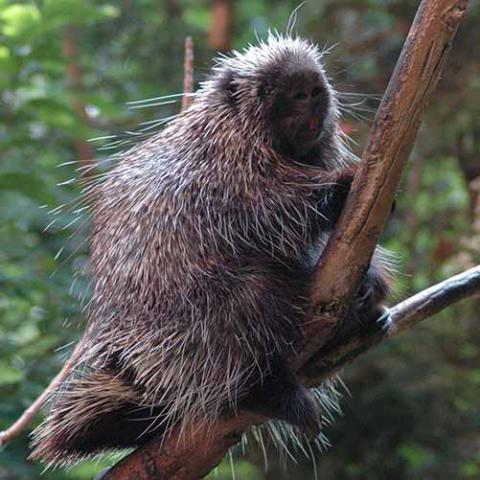NAMES
TAXONOMY
Canada
Issued:
Stamp:
Erethizon dorsatum
Canada
Issued:
Stamp:
Erethizon dorsatum
Canada
Issued:
Stamp:
Erethizon dorsatum
In mid June, while living on the Shawangunk Mountains in Ulster County, NY, I was lucky enough to watch this cute, young porcupine go about having a meal of a young sapling. Clearly the motor skills were still in the process of being developed and refined, yet I believe that enough leaves made it into the mouth to make a satisfying and successful meal. A few months later, I did spot a more mature porcupine scurrying along a stream bank. Whether it was the same one I saw as a youngster or not, I wasn't sure.
Video: P. Needle
Genus species (Animalia): Erethizon dorsatum
The North American porcupine (Erethizon dorsatum), also known as the Canadian porcupine, is a large rodent in the New World porcupine family. The beaver is the only rodent in North America that is larger than the North American porcupine. The porcupine is a caviomorph rodent whose ancestors rafted across the Atlantic from Africa to Brazil over 40 million years ago, and then migrated to North America during the Great American Interchange after the Isthmus of Panama rose 3 million years ago.
Etymology
The word "porcupine" comes from the middle or old French word porcespin, which means thorn pig. Its roots derive from the Latin words porcus or pig and spina meaning thorns. Other colloquial names for the animal include quill pig. It is also referred to as the Canadian porcupine or common porcupine. The porcupine's scientific name, Erethizon dorsatum, can be loosely translated as "the animal with the irritating back". Several Native American names exist, such as the Lakota name pahin meaning quill and the Chipewyan name ts'l.
Description
Porcupines are usually dark brown or black in color, with white highlights. They have a stocky body, a small face, short legs, and a short, thick tail. This species is the largest of the New World porcupines and is one of the largest North American rodents, second only to the American beaver in size. The head-and-body length is 60 to 90 cm (2.0 to 3.0 ft), not counting a tail of 14.5 to 30 cm (5.7 to 11.8 in). The hind foot length is 7.5 to 9.1 cm (3.0 to 3.6 in). Weight can range from 3.5 to 18 kg (7.7 to 39.7 lb). Weight in adult females can average some 7 kg (15 lb) while 5 wild-caught males averaged 10.67 kg (23.5 lb).
The porcupine is the only native North American mammal with antibiotics in its skin. Those antibiotics prevent infection when a porcupine falls out of a tree and is stuck with its own quills upon hitting the ground. Porcupines fall out of trees fairly often because they are highly tempted by the succulent buds and twigs at the ends of the branches. The porcupine, the wolverine, and the skunk are the only North American mammals that have strongly contrasting black-and-white coloration, because they are the only mammals that benefit from letting other animals know where and what they are in the dark of night.
Quills
The most distinguishing feature of the porcupine is its coat of quills. An adult porcupine has about 30,000 quills that cover all of its body except its underbelly, face, and feet. Quills are modified hairs formed into sharp, barbed, hollow spines. They are used primarily for defense, but also serve to insulate their bodies during winter. Porcupines do not throw their quills, but when threatened, they contract the muscles near the skin, which causes the quills to stand up and out from their bodies. When the quills are in this position, they become easier to detach from the body, especially when a porcupine swings its tail toward an attacker. The barbs at the tail tip become lodged in the flesh of an attacker and are difficult and painful to remove. The quills are normally flattened against the body and in this position are less easily dislodged.
Stench
The North American porcupine has a strong odor to warn away predators, which it can increase when agitated. The smell has been described as similar to strong human body odor, goats, or some cheeses. The odor is generated by a patch of skin called the rosette, on the lower back where modified quills serve as osmetrichia to broadcast the smell. The characteristic odor comes from the R-enantiomer of delta-decalactone. Not present is the S-enantiomer which smells like coconut and is used in flavorings and perfumes.



